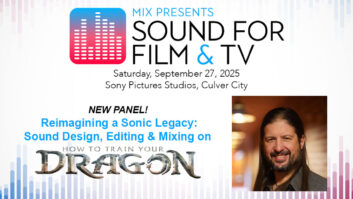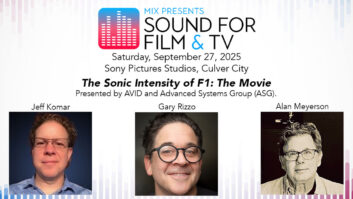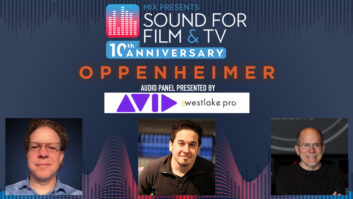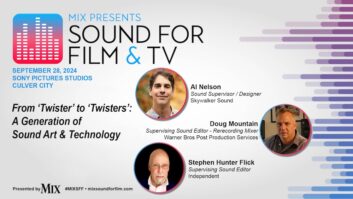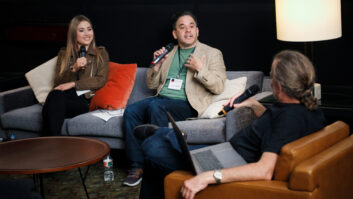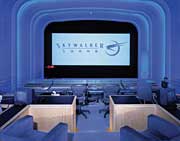
Mix D at Skywalker Sound
All photos Lucasfilm Ltd. All rights reserved. Used by permission.
We tend to give a lot of ink to Skywalker Sound, and with good reason. First, it’s Skywalker Sound, and the mystique generated by the name itself has reached beyond our industry into the worldwide vernacular; sort of like Abbey Road. Second, its independence is anathema in this age of consolidation, with companies like Ascent and Technicolor challenging the studio lots with new economies of scale. And third, the people at Skywalker have quite simply set the standards for feature film sound, both technically and creatively.
Star Wars, Indiana Jones, Terminator 2, Jurassic Park, Fight Club, Contact, Saving Private Ryan, Titanic, Finding Nemo — these are the types of films that have pushed the proverbial envelope of film sound over the past 25 years, and all were edited and mixed at Skywalker Sound, along with countless others. On the day Mix visited this fall, Pixar’s The Incredibles had just wrapped, Randy Thom was finishing up the final on Polar Express and Christopher Boyes was nearly done with the dark and moody effects premix on the new Gore Verbinski picture, The Weather Man.
So the rooms are full, at least for now, and on the horizon is Star Wars Episode III, so the Technical Building will remain lively. But even the top facilities are under pressure to fill rooms these days — and it’s not easy. With fewer films in production, the UK tax credit leading to offshore mixes and the ongoing consolidation among post facilities, it’s tougher than ever to bring in moneymaking projects for any length of time. Consequently, everybody in post, Skywalker included, is looking for new opportunities.
Toward that end, Skywalker recently underwent a major expansion and renovation of its famed Technical Building. Two of the larger mix stages, G and D, have been rebuilt to include large client lounges and producer areas, with large glass windows opening onto the dub stage. Nine new 6.1 sound design/premix rooms, all tied to the various stages, are coming online. Also, a Hitachi 9980V central storage server was added, along with Apple Xserve and Xraid, bringing machine room FibreChannel storage to 38 terabytes. And a new Skylink service, developed with codec manufacturer APT Technologies, has been implemented for remote work.

Glenn Kiser
“We were handed this pretty big mandate from George [Lucas] in anticipation of Episode III,” says VP/general manager Glenn Kiser. “Basically, we want to minimize our need to be on an expensive mixing stage for predubbing. So everything on Star Wars is to be predubbed in the workstations in a 6.1 environment, and we only go to the dub stage for the final mix. We’ve used that approach successfully in the past on some lower-budget features, but never on a movie of the scope and complexity of Star Wars. We’re changing the physical space, but we’re changing it to match a working style that we’ve been developing over the course of many years, one where we blur the lines between the edit and the mix.”
“We’re finally able to reach the vision that George had for digital post back in 1984 when he built this place,” adds Tim McGovern, director of engineering.
So what’s good for Star Wars should be good for outside clients. Over the past few years, Skywalker has continued to get its share of blockbuster sound jobs, but, reflecting the industry at large, they’ve also seen a rise in the number of budget-challenged independent projects. The new facility, according to Kiser, will allow clients to take advantage of the edit/mix talent, make use of the world-renowned library and provide scheduling/budget flexibility.
At the same time, it’s no secret that Skywalker will be making a bigger push into television sound. By making use of its remote APT services, the facility recently contracted with Fuji Television in Japan for a feature film called Lorelei. The mix is done at Skywalker, then encoded and sent “store and forward” to a local hard drive in Japan for approval. Using this new remote collaboration technology, they also have started work on Nightmare on Elm Street, a New Line TV series. Mixes are done in Northern California, then sent directly into the cutting room in L.A. for layback.
“TV has always been a difficult market for us because of geography,” Kiser explains. “But using our remote collaboration tools, we can send mixes directly to the picture editing rooms in L.A., and it’s actually easier than having people drive across town. So we can do TV, documentaries, short form and long form. If you listen to these shows, the gap between feature film sound and television sound is narrowing. And as HBO and those types of groups move more into HD broadcasting, the bar will only get higher in terms of sound expectations.”
This new working model, housed in one of the world’s leading post-production facilities, both reflects what’s going on in the industry at large and establishes a benchmark for smooth, flexible operation at the top end. Yes, Ascent, Technicolor, Universal, Sony and others are incorporating similar creative/technical methodologies, and people have been mixing in Pro Tools for years, but as one of the last of the independents, Skywalker has once again put its stamp on the creative use of technology.

